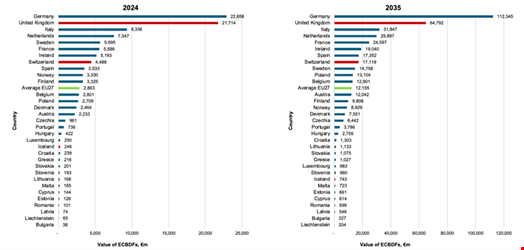Table of Contents
Europe’s digital economy relies on infrastructure most people never see. Beneath the surface – both figuratively and literally – submarine cables carry a material proportion of cross-border internet traffic, including the data flows generated by the cloud services used by European enterprises.
This article explores the magnitude of these data flows and highlights the growing importance they play from the perspective of EU policymakers.
This importance underscores the need for stronger cyber resiliency to be built into this digital infrastructure.
Beyond Telecoms: The Wider Impact of Disruption
When undersea cables in the Baltic Sea were disrupted in 2024, much of the discourse around cable security focused on the immediate costs to operators and cloud providers. Repair operations required the diversion of millions from more productive investments, while outages dented trust and revenue.
But this is a narrow lens. As our recent study for the European Commission makes clear, the value of enterprise cloud-based data flows (ECBDFs) extends far beyond the tech and telecommunications sectors. The flows crossing these undersea cables support industrial processes, health services, logistics and even environmental goals.
For example, as shown in the figure below, in 2024, the sectors estimated to generate the largest volumes of these data flows were manufacturing (7600 PB), wholesale and retail (6400 PB), and health and social care (5300 PB).
These industries may be more analogue than digital in reputation, but they employ a large proportion of Europe’s workforce – and their growing use of cloud services turns many operations into data-intensive ones.

Cloud-Based Data Flows as Drivers of Economic Value
What also emerges as particularly remarkable is that these vast volumes of cloud-based data flows translate into real economic value. For example, in 2024, cloud-based data flows are estimated to have generated €107bn ($120bn) of economic value across the EU, EFTA and the UK.
For comparison, that’s more than the entire GDP of Bulgaria. This value is driven by three main components:
- €95.7bn ($108.1bn) in additional gross value added (GVA) by European enterprises using cloud services. This is the economic value that enterprises using cloud services are estimated to extract from these data flows (i.e., the demand side).
- €11bn ($12.4bn) in profits for cloud service providers. This is the value generated on the supply side of the cloud industry.
- Around €0.3bn ($0.34bn) in broader economic externalities – mostly job creation, and GHG emissions linked to infrastructure.
Importantly, as shown in the figure below, the economic footprint of these data flows is not confined to where the connecting infrastructure sits. Data flows create value even in countries far from the seabed cables. That’s the essence of the cloud: decentralized access, centralized management.

Building Digital Resilience: Europe’s Next Strategic Frontier
While cloud and infrastructure providers already invest in redundancy, backups, re-routing and satellite links, such technical safeguards might not suffice if threats become more systemic or politically motivated.
This is why policymakers are beginning to pay attention. In February 2024, the European Commission issued a Recommendation on Secure and Resilient Submarine Cable Infrastructures.
It called for Member States to work with private stakeholders to “identify critical submarine cable infrastructures, assess risks, and develop coordinated preparedness and response measures” across the EU’s digital corridors. It also proposed creating an “EU Cable Security Toolbox” and hinted at the possible need for joint financing or enhanced incident response capabilities. In short: Europe is waking up to the fragility of its digital lifelines.
Our report for the European Commission reinforces the rationale for such intervention and shows that cloud-based data flows are expected to grow rapidly in both scale and economic value.
By 2035, enterprise cloud-based data flows originating in the EU are expected to reach 5.6 million petabytes per year – 120 times the volume recorded in 2024. At the same time, the value of these flows is forecast to rise to €328bn ($370.6bn), more than four-times today’s levels. This sharp acceleration reflects the deepening role of cloud infrastructure in every sector of the economy.
As data volumes and economic value grow, and as infrastructure becomes more distributed through edge computing, Europe could have an opportunity to shape a more resilient digital architecture. Whether this translates into sustained policy action or remains a set of guiding principles will likely depend on how the risks evolve – and how seriously they are taken.
